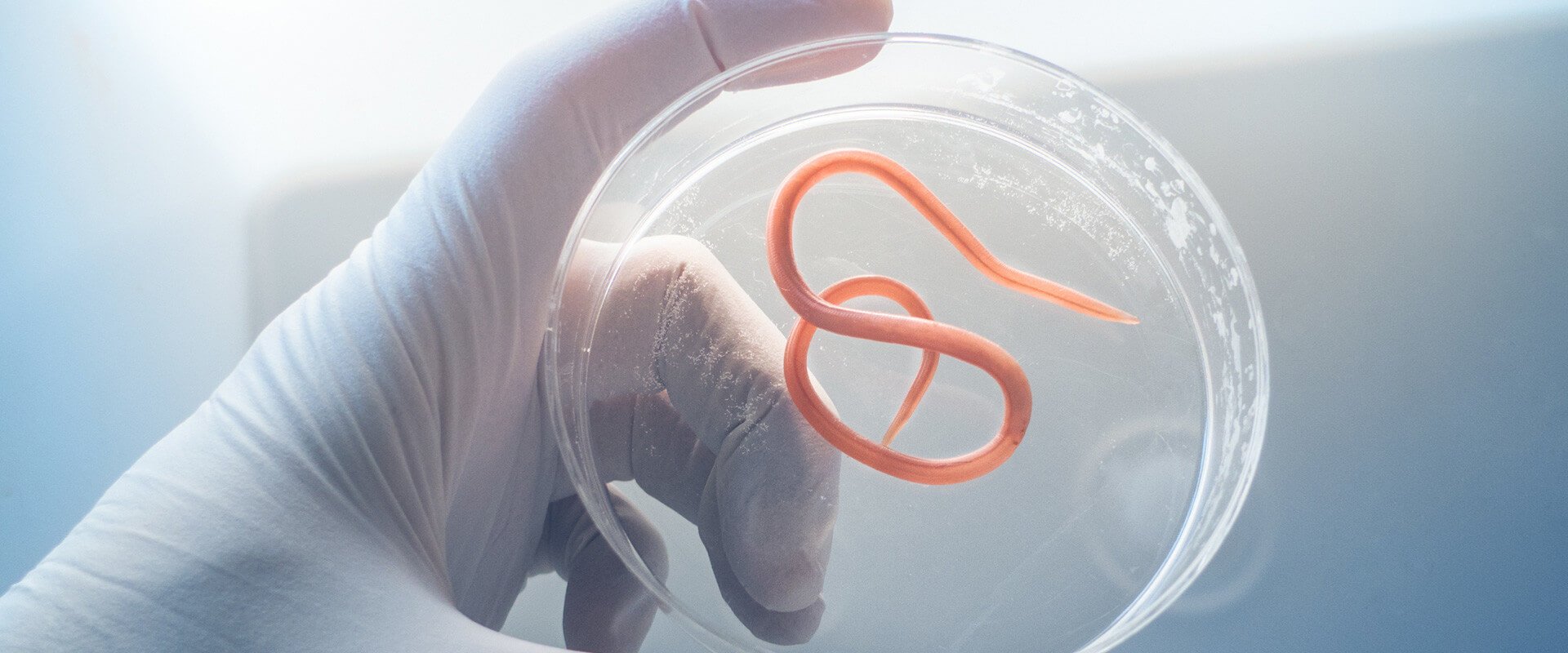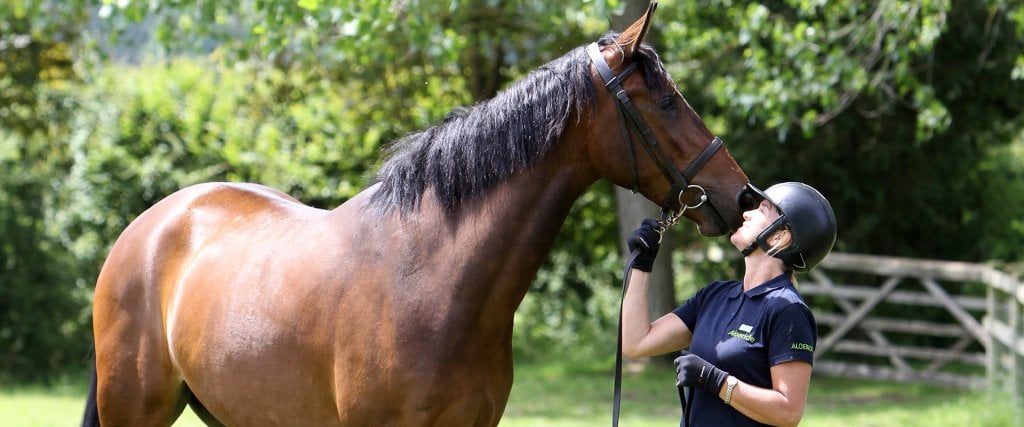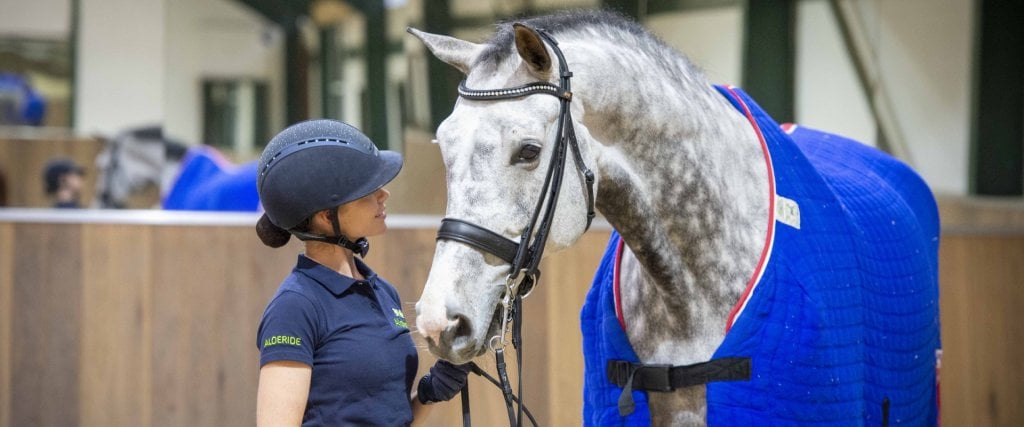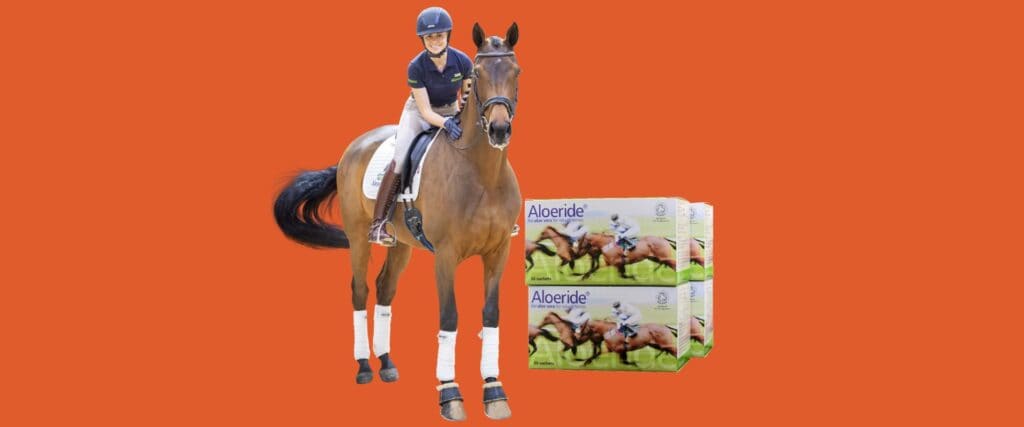The Problem Of Parasites
The problem of parasites in horses is, as you know, that all horses have ’em. But domesticated horses require worming vigilance to keep parasites from harming the horse, whilst horses in the wild have a natural ability to limit their impact. So, is the only acceptable level of parasites zero and can you do something to help your horse’s natural ability to keep parasites more in check?
 Nature is so designed that most parasites have a commensal relationship with their host (i.e. one organism benefits whilst the other is neutral). Parasites benefit little from killing their host, their source of breakfast, lunch, supper and a warm bed. Wild, roaming horses never get chemical deworming and yet they survive, reproduce and raise young. Beyond their obvious geographical freedom (here’s where the quality and size of your pasture and stable management comes into it) they have robust defences to ensure that commensalism doesn’t spiral into parasitism (i.e. one organism benefits whilst the other suffers). The key to success is an optimum gut ecosystem. A natural balance is maintained by catching the parasitic cycle at its weakest (i.e. as egg) whilst defensive mechanisms are kept strong. Nature limits a horse’s parasitic load the moment those eggs that survive gastric acidity (this very much is a part of natural defence) enter the gut only to meet a self-defensive bowel flora and digestive enzymes. The smaller an egg’s prospects of commensal living conditions is, the smaller the chance of it growing into a parasite.. Those eggs that do, face an uphill ride inside an inhospitable ecosystem, thus their burden remains limited. Aloeride aloe vera helps to build such a healthily, naturally inhospitable gut ecosystem. It helps to make your horse less susceptible to parasitic infection. A natural way to manage the problem of parasites.
Nature is so designed that most parasites have a commensal relationship with their host (i.e. one organism benefits whilst the other is neutral). Parasites benefit little from killing their host, their source of breakfast, lunch, supper and a warm bed. Wild, roaming horses never get chemical deworming and yet they survive, reproduce and raise young. Beyond their obvious geographical freedom (here’s where the quality and size of your pasture and stable management comes into it) they have robust defences to ensure that commensalism doesn’t spiral into parasitism (i.e. one organism benefits whilst the other suffers). The key to success is an optimum gut ecosystem. A natural balance is maintained by catching the parasitic cycle at its weakest (i.e. as egg) whilst defensive mechanisms are kept strong. Nature limits a horse’s parasitic load the moment those eggs that survive gastric acidity (this very much is a part of natural defence) enter the gut only to meet a self-defensive bowel flora and digestive enzymes. The smaller an egg’s prospects of commensal living conditions is, the smaller the chance of it growing into a parasite.. Those eggs that do, face an uphill ride inside an inhospitable ecosystem, thus their burden remains limited. Aloeride aloe vera helps to build such a healthily, naturally inhospitable gut ecosystem. It helps to make your horse less susceptible to parasitic infection. A natural way to manage the problem of parasites.
 Racehorse trainers confirm that killing parasites (via chemical or natural anthelmintic) results in a dip in race performance, look at the diagram why this happens. Endoparasites excrete metabolic waste (endotoxins) that is toxic to the host and must be biodegraded by the liver. A small endotoxic load won’t affect a well-nourished, immune-competent horse. But if a parasite burden increases, the toxic load becomes bigger. Also such burden robs feed nutrients (see Guess What Came To Dinner) that were intended for the horse. A reduced nutrient uptake (minus nutrients requisitioned for detoxification pathways) often results in a dull coat, loss of condition and altered behaviour. Endotoxins that do not find their way out of the system via liver pathways or urinary tract may seek to exit via the skin (any mammal’s largest excretory organ) which can cause itching (pruritus). Significant parasite burden causes a rise of endotoxins but then, so can killing them off too fast, even with natural anthelmintics that do not affect CNS and GABA. A sachet of Aloeride a day helps to build a healthily inhospitable gut ecosystem.
Racehorse trainers confirm that killing parasites (via chemical or natural anthelmintic) results in a dip in race performance, look at the diagram why this happens. Endoparasites excrete metabolic waste (endotoxins) that is toxic to the host and must be biodegraded by the liver. A small endotoxic load won’t affect a well-nourished, immune-competent horse. But if a parasite burden increases, the toxic load becomes bigger. Also such burden robs feed nutrients (see Guess What Came To Dinner) that were intended for the horse. A reduced nutrient uptake (minus nutrients requisitioned for detoxification pathways) often results in a dull coat, loss of condition and altered behaviour. Endotoxins that do not find their way out of the system via liver pathways or urinary tract may seek to exit via the skin (any mammal’s largest excretory organ) which can cause itching (pruritus). Significant parasite burden causes a rise of endotoxins but then, so can killing them off too fast, even with natural anthelmintics that do not affect CNS and GABA. A sachet of Aloeride a day helps to build a healthily inhospitable gut ecosystem.
Sally Toye who is a highly respected Endurance GB rider found that the egg count changed in her two horses on Aloeride: “P.S. just worm tested both ponies and they have the lowest count ever which is nil, I think their guts are just fab… their counts have improved all year and I have used minimum wormers this year… so there is definitive proof that Aloeride works xx” Sally is of course not the only rider who noticed this, many others noticed that meaningful, everyday servings feed a healthily inhospitable environment.Deworming drugs fall into three classes (Macrocyclic lactones i.e. ivermectin and moxidectin, Benzemidazoles i.e. fenbendazole and Pyrimidines i.e. pyrantel). It is fair to say that their prescribing attitudes mimicked those of antibiotics in humans, and exactly the same concern has surfaced, that of resistance. To quote the World Health Organisation: “Antimicrobial resistance (AMR) threatens the effective prevention and treatment of an ever-increasing range of infections caused by bacteria, parasites, viruses and fungi”. Now there’s a much more prudent use of antibiotics in humans as well as a changing approach in the use of anthelmintics in horses. The goal of modern deworming is a) to control the parasite load in the pasture through management and b) identify and treat individual horses that shed high levels of eggs into droppings. Not all horses do! After using a dewormer, check the faecal egg count after ten to fourteen days to be certain the protocol worked. The egg count should have decreased by 90% at least. Horses that are egg shedders should be rechecked in six to eight weeks and dewormed again if egg count dictates this. Which begs the familiar question, is the only acceptable level of parasites zero?
Symbiosis with parasites
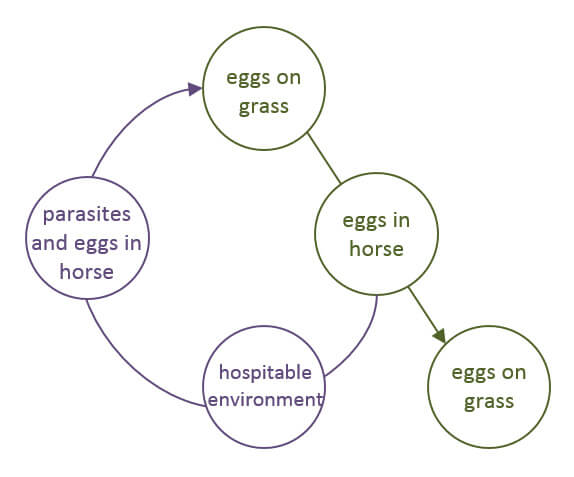 Nature is so designed that most parasites have a commensal relationship with their host (i.e. one organism benefits whilst the other is neutral). Parasites benefit little from killing their host, their source of breakfast, lunch, supper and a warm bed. Wild, roaming horses never get chemical deworming and yet they survive, reproduce and raise young. Beyond their obvious geographical freedom (here’s where the quality and size of your pasture and stable management comes into it) they have robust defences to ensure that commensalism doesn’t spiral into parasitism (i.e. one organism benefits whilst the other suffers). The key to success is an optimum gut ecosystem. A natural balance is maintained by catching the parasitic cycle at its weakest (i.e. as egg) whilst defensive mechanisms are kept strong. Nature limits a horse’s parasitic load the moment those eggs that survive gastric acidity (this very much is a part of natural defence) enter the gut only to meet a self-defensive bowel flora and digestive enzymes. The smaller an egg’s prospects of commensal living conditions is, the smaller the chance of it growing into a parasite.. Those eggs that do, face an uphill ride inside an inhospitable ecosystem, thus their burden remains limited. Aloeride aloe vera helps to build such a healthily, naturally inhospitable gut ecosystem. It helps to make your horse less susceptible to parasitic infection. A natural way to manage the problem of parasites.
Nature is so designed that most parasites have a commensal relationship with their host (i.e. one organism benefits whilst the other is neutral). Parasites benefit little from killing their host, their source of breakfast, lunch, supper and a warm bed. Wild, roaming horses never get chemical deworming and yet they survive, reproduce and raise young. Beyond their obvious geographical freedom (here’s where the quality and size of your pasture and stable management comes into it) they have robust defences to ensure that commensalism doesn’t spiral into parasitism (i.e. one organism benefits whilst the other suffers). The key to success is an optimum gut ecosystem. A natural balance is maintained by catching the parasitic cycle at its weakest (i.e. as egg) whilst defensive mechanisms are kept strong. Nature limits a horse’s parasitic load the moment those eggs that survive gastric acidity (this very much is a part of natural defence) enter the gut only to meet a self-defensive bowel flora and digestive enzymes. The smaller an egg’s prospects of commensal living conditions is, the smaller the chance of it growing into a parasite.. Those eggs that do, face an uphill ride inside an inhospitable ecosystem, thus their burden remains limited. Aloeride aloe vera helps to build such a healthily, naturally inhospitable gut ecosystem. It helps to make your horse less susceptible to parasitic infection. A natural way to manage the problem of parasites.
Here is your introductory Aloeride Offer!
Give your horse 12 litres of Soil Association Organic Aloe Vera Barbadensis Miller in 30 palatable powder servings. One supplement with many benefits to your horse (and you)..
Vulnerability to parasites
Of course some parasites are killers! But large strongyles, that caused serious and devastating colics, were common before modern anthelmintics came into use. Small strongyles are not much of a clinical problem unless a horse is in poor condition and has a heavy parasite load. Horses that have been ill, have poor immune systems, or have been treated extensively with antibiotics are likely to have a vulnerability to parasites. So are horses that are on stomach acidity reducing medication, because this scuppers your horse’s first line of defense against parasites (and more). Consider the prevelance of EGUS (any degree of stomach wall erosion), consider the use of omaprazole (notably as maintenance), consider how this affects vulnerability to parasites and FEC. Think upstream and, beyond hygiene, consider feeding a higher protein quantity (e.g. Sainfoin Onobrychis viciifolia) as this is known to improve your horse’s susceptibility to parasites. Proteins are made up of (digestively reduced to) amino acids – Aloeride offers a very broad spectrum (and amino acid variability is key) – and note that the protein level of absorption (i.e. biological value) of pasture grasses and hays ranges from 45 to 80 percent, so adjust dosage upwards accordingly. For rebuilding the gut ecosystem, a potential starting point is a gradual introduction of ½ sachet a day over a few observant days to the normal quantity of 1 sachet a day sprinkled over feed plus live culture probiotics (i.e. not just yeast; consider using well-fermented milk kefir) whilst being prudent with total carbohydrate load. An additional natural approach to the problem of parasites that is used by Dr.med.vet. Xaver Sterrer, who is a FEI Permitted Veterinarian, is the Para-Rizol that Han van de Braak BSc LicAc MCSP MBAcC (Retd.) also used in his practice for microbial cleansing. A buoyant immune system further develops with proper broad spectrum nutrition and equine fitness.Intox (Endotox) vs. Detox
Chemical wormers must be toxic in order to work. Adverse reactions are caused by their effect on the Central Nervous System (CNS), forcing an increased release of the neurotransmittor GABA. CNS symptoms include ataxia (uncoordinated movements), hypermetria (excessive or disproportionate movements), tremor (uncoordinated trembling or shaking movements), disorientation and hyperaesthesia (excessive sensitivity). Foals, weanlings and yearlings are considered a high risk for deworming because they don’t have a fully developed blood-brain barrier and thus are more vulnerable to toxicity. Beyond the toxicity of chemical wormers, parasite die-off releases parasitic endotoxins and these two together make for the total toxic load needing to be detoxified by your horse’s liver.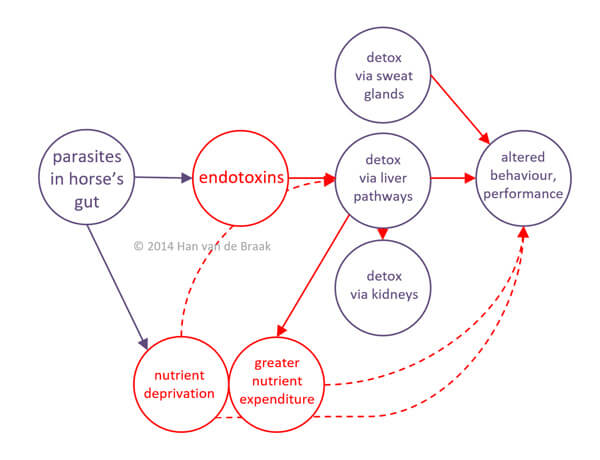 Racehorse trainers confirm that killing parasites (via chemical or natural anthelmintic) results in a dip in race performance, look at the diagram why this happens. Endoparasites excrete metabolic waste (endotoxins) that is toxic to the host and must be biodegraded by the liver. A small endotoxic load won’t affect a well-nourished, immune-competent horse. But if a parasite burden increases, the toxic load becomes bigger. Also such burden robs feed nutrients (see Guess What Came To Dinner) that were intended for the horse. A reduced nutrient uptake (minus nutrients requisitioned for detoxification pathways) often results in a dull coat, loss of condition and altered behaviour. Endotoxins that do not find their way out of the system via liver pathways or urinary tract may seek to exit via the skin (any mammal’s largest excretory organ) which can cause itching (pruritus). Significant parasite burden causes a rise of endotoxins but then, so can killing them off too fast, even with natural anthelmintics that do not affect CNS and GABA. A sachet of Aloeride a day helps to build a healthily inhospitable gut ecosystem.
Racehorse trainers confirm that killing parasites (via chemical or natural anthelmintic) results in a dip in race performance, look at the diagram why this happens. Endoparasites excrete metabolic waste (endotoxins) that is toxic to the host and must be biodegraded by the liver. A small endotoxic load won’t affect a well-nourished, immune-competent horse. But if a parasite burden increases, the toxic load becomes bigger. Also such burden robs feed nutrients (see Guess What Came To Dinner) that were intended for the horse. A reduced nutrient uptake (minus nutrients requisitioned for detoxification pathways) often results in a dull coat, loss of condition and altered behaviour. Endotoxins that do not find their way out of the system via liver pathways or urinary tract may seek to exit via the skin (any mammal’s largest excretory organ) which can cause itching (pruritus). Significant parasite burden causes a rise of endotoxins but then, so can killing them off too fast, even with natural anthelmintics that do not affect CNS and GABA. A sachet of Aloeride a day helps to build a healthily inhospitable gut ecosystem.

